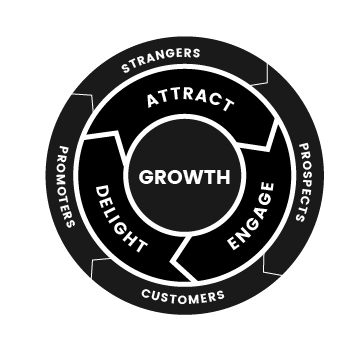As we move into 2022, we need to think about moving from a funnel model to engaging and delighting clients, so they become the micro-influencers for our brand and business.

THE SHIFT FROM FUNNELS TO FLYWHEELS

As marketers, it is often challenging to set aside time to reflect on what we can do to ensure we stay ahead of changing patterns and trends in B2B or B2C businesses. We know we should spend time reflecting and thinking about emerging patterns and how we can remain agile and adapt. Yet, the pressure of daily demands means that if something is working, we tend to stick with it, hoping it will continue working.
The purpose of this article is to present one of the changes that are beginning to occur across markets. The move from a marketing funnel model to that of the flywheel.
THE MARKETING FUNNEL
We are familiar with the marketing funnel model:

In this model, the customer is at the bottom of the funnel. Everything we do is designed to move a person through the funnel, from awareness to purchasing our product and becoming a client.
In the funnel model, the emphasis is on the product or service we are providing. Businesses ensure they provide a product or service that meets a customer’s need. The emphasis is on the product or service provided, rather than the client with a customer experience. There is the expectation that if the product or service meets the needs of the client sufficiently well enough, they will become repeat customers allowing the business to grow.
THE FLYWHEEL MODEL

The flywheel model shifts the emphasis from the product sold to the customer's experience. In this approach, businesses and brands seek to provide the customer with an experience that engages them, not just a product, to meet a need. Hence the importance of continually delighting and engaging customers and prospects.
One way businesses are engaging with customers and potential customers is by developing micro-influencers. The micro-influencers, share their experience so engaging other potential customers or clients.
When businesses place the customer experience at the centre of how they engage with clients and aim to engage and delight them, companies have the opportunity to create micro-influencers who become brand ambassadors
INFLUENCERS AND MICRO-INFLUENCERS
One of the increasing trends in marketing is the use of influencers. 57% of marketers that currently use influencer marketing say it is effective in building brand awareness. 46% of marketers are looking at increasing their use of influencers in 2022 [1].
However, not all businesses have the marketing spend to engage influencers who have extensive followings. This is where micro-influencers can be important. In fact, micro-influencers can be more effective than celebrity influencers for several reasons.
Firstly, micro-influencers often have higher engagement rates from their followers. This is because they are targeting a niche area and are connecting with people who are interested in the same area. The second reason is that micro-influencers are seen as ordinary people; hence, their opinions and views often carry greater weight than celebrities.
When businesses place the customer experience at the centre of how they engage with clients and aim to engage and delight them, companies have the opportunity to create micro-influencers who become brand ambassadors.
HOW DO I BEGIN TO SHIFT FROM THE FUNNEL TO THE FLYWHEEL?
Like any change, it is best to start slowly. Changing one thing at a time allows us to consolidate that change and ensure it is effective before embarking on the next step. However, three ways we can start considering the flywheel model are:
1. EDUCATE YOURSELF
If you haven't heard of or considered the flywheel model before, take some time to read and get more information on it. Some resources include:
1. Flywheel Marketing: New Growth & Revenue Model
2. The Flywheel Model
2. SELLING A PRODUCT OF SOLVING A PROBLEM?
Are you selling a product to your client or helping them solve a problem? We may think we have the best product on the market, but it will have no traction with our target customers unless we communicate how our product resolves a problem they are experiencing.
Businesses often use their website to talk about themselves rather than using their website to talk about how they can solve a client's problem.
We need to think and be clear about what problem our product is solving for our clients and crystalise this message.
3. MOBILE OPTIMISED EXPERIENCES
As the buying power of millennials and Gen Z increases, businesses need to make sure they are providing mobile optimised experiences. Increasing numbers of marketers are investing in mobile web design to ensure they reach young people in this cohort who predominantly use mobile phones.
As we move into the new financial year we want to think about moving from a funnel model to engaging and delighting clients, so they become the micro-influencers for our brand and business.





